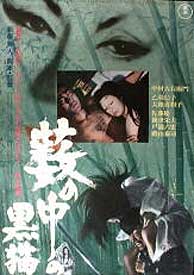 The highly respected Kaneto Shindo wrote & directed Kuroneko (Yabu no naka no kuroneko, literally "Black Cat of the Grove," Toho, 1968), sometimes shown as The Black Cat, the literal translation of Kuroneko. The highly respected Kaneto Shindo wrote & directed Kuroneko (Yabu no naka no kuroneko, literally "Black Cat of the Grove," Toho, 1968), sometimes shown as The Black Cat, the literal translation of Kuroneko.
It was filmed in the wake of an unexpected international success with Shindo's masterpiece of horror Onibaba (Toho, 1964). That tale of an appalling mask was a lot more original than the "vengeful cat-demon" theme, for which scores of versions have been filmed (see the essays Ghost Cats & Blind Masseurs & A Few Bakeneko-mono Ghost-Cat Movies). But even with so much competition in this curious sub-genre, Shindo made one of the best bakeneko-mono (monster cat tales) of them all.
In a time of civil war, in the 11th Century, a group of samurai with their squadron leader (Rokko Toura) happen on a woodland hut near Kyoto. As they search the hut for food, they find a cowering mother & daughter-in-law (Nobuko Otawa & Kiwako Taichi from Onibaba) whom they promptly ravage & kill, covering their crime by setting the hut ablaze. When the ashes have cooled, a cat is seen lapping blood from the charred corpses, the pivitol act that in Japanese folklore will transform slain women into avenging cat-spirits.
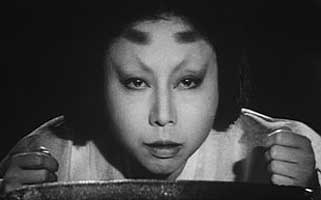 Some while later the samurai who led the assault on the poor little hut has a position as a vassal who patrols the outskirts of Kyoto on horseback. On a quiet path through a bamboo grove, he encounters a young noblewoman who requests he see her safelty to her home. When they arrive at her home, she behaves seductively toward the vassal, but at the moment of his most eager expectation, she suddenly bites him & sucks out his blood. He is discovered at dawn dead among the ashes of a burnt hut. Some while later the samurai who led the assault on the poor little hut has a position as a vassal who patrols the outskirts of Kyoto on horseback. On a quiet path through a bamboo grove, he encounters a young noblewoman who requests he see her safelty to her home. When they arrive at her home, she behaves seductively toward the vassal, but at the moment of his most eager expectation, she suddenly bites him & sucks out his blood. He is discovered at dawn dead among the ashes of a burnt hut.
As the mother & daughter ghosts increase the numbers of their victims, the issue is brought to the attention of the mikado (Hideo Kanze), who insists that Minamoto no Raiko (Kei Sato) resolve the mysterious trouble. He sends his best man, an ex-farmer who rose to the status of a samurai vassal during the civil wars. Gintoki (Kichiemon Nakamura). He soon discovers that the ghost-cats are the revenge-spirits of his own mother & wife, & he is tormented by the loss of his previouis life & his duty under his new samurai status.
The gorgeous atmospherics of the black & white photography, & the angst experienced by the torn Gintoki who well knows what it meant to be a peasant in a world ruled by warriors, makes this film much more than its surface spook-story. Aesthetics inform every scene, & the contrast between of a comely young woman's performance of a Noh dance & the grotesquery of her falling upon her startled victim is the keynote of the film's combination of beauty & horror.
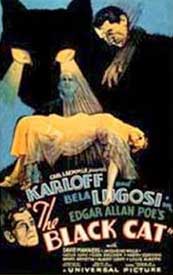 In the west black cats are considered unlucky, but don't much resemble the cat legends of Japan. The Japanese version is a vampiric cat & generally restricted to stories of women's revenge. The western association of the black cat as a familiar to a witch may well be borrowed from Asian folklore, but when the black cat turns up in American & European cinema, it is more symbolic than a major presence. In the west black cats are considered unlucky, but don't much resemble the cat legends of Japan. The Japanese version is a vampiric cat & generally restricted to stories of women's revenge. The western association of the black cat as a familiar to a witch may well be borrowed from Asian folklore, but when the black cat turns up in American & European cinema, it is more symbolic than a major presence.
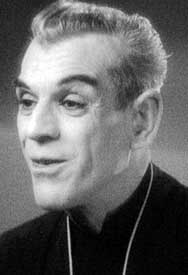 Edgar Allen Poe's short mystery tale "The Black Cat" with the hangman's noose symbol in white upon its throat is something of an avenging cat, somewhat resembling the Asian idea that a white mark on a black cat's fur contains the soul of a vengeful spirit. Edgar Allen Poe's short mystery tale "The Black Cat" with the hangman's noose symbol in white upon its throat is something of an avenging cat, somewhat resembling the Asian idea that a white mark on a black cat's fur contains the soul of a vengeful spirit.
Although not a big sub-genre unto itself, Poe's influence has given cats a certain cinematic presence in horror. Edgar Bulmer's The Black Cat (1934) was inspired by though in no way based on the Poe story. It featured two great horror stars together for the first time: Boris Karloff as the sinister Professor Poelzig, & Bela Lugosi as the avenging Dr. Werdegast.
Rather than the usual gothic mansion of such tales, The Black Cat is set somewhat inexplicably in an ultra-modern or even slightly futuristic home in of all places Hungary. The modernist mansion was designed by the evil Professor atop a mausoleum that is a mass grave of WWI casualties.
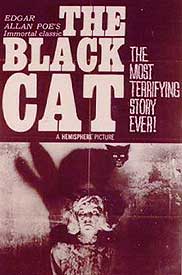 In this startling environment, torture of women, the professor's Satan worship & the doctor's cat phobia make for a sicko decadent parable decades ahead of its time for outright grotesquery. This one deserves its recognition as a classic. In this startling environment, torture of women, the professor's Satan worship & the doctor's cat phobia make for a sicko decadent parable decades ahead of its time for outright grotesquery. This one deserves its recognition as a classic.
Showing a closer inspiration from Poe, if less imagination over all, is Harold Hoffman's The Black Cat (1966), about a wife-killer (Robert Frost who can't act for shit) convinced the cat he tortured & electrocuted has returned to haunt him. The "irony" of the piece regards Lou getting electro shock therapy in the madhouse, duplicating the cat's fate.
It was an Independent production made in Texas for the drive-in circuit, which was the equivalent of direct-to-video in days before video. It tosses in some rock 'n' roll which was briefly required for drive-in cheapies.
It can be fun like other regional independents of the era, but enter into the experience with the lowest expectations. Think of it as a no-budget axe-in-the-head film gross for 1966 but far outpaced since.
A much more thrilling film partially inspired by Poe's tale of the black cat is Maniac (1934), & a number of other black cat films from the United States & Europe might be cited to show some slight affinity between western & asian cinemas. But the origins of the Japanese portion of demonic cat tales are in the main from the late Tokugawa period kabuki plays & Meiji era pulp fiction, predating influences from the west.
copyright © by Paghat the Ratgirl
|
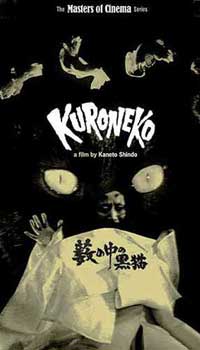

 Some while later the samurai who led the assault on the poor little hut has a position as a vassal who patrols the outskirts of Kyoto on horseback. On a quiet path through a bamboo grove, he encounters a young noblewoman who requests he see her safelty to her home. When they arrive at her home, she behaves seductively toward the vassal, but at the moment of his most eager expectation, she suddenly bites him & sucks out his blood. He is discovered at dawn dead among the ashes of a burnt hut.
Some while later the samurai who led the assault on the poor little hut has a position as a vassal who patrols the outskirts of Kyoto on horseback. On a quiet path through a bamboo grove, he encounters a young noblewoman who requests he see her safelty to her home. When they arrive at her home, she behaves seductively toward the vassal, but at the moment of his most eager expectation, she suddenly bites him & sucks out his blood. He is discovered at dawn dead among the ashes of a burnt hut.
 Edgar Allen Poe's short mystery tale "The Black Cat" with the hangman's noose symbol in white upon its throat is something of an avenging cat, somewhat resembling the Asian idea that a white mark on a black cat's fur contains the soul of a vengeful spirit.
Edgar Allen Poe's short mystery tale "The Black Cat" with the hangman's noose symbol in white upon its throat is something of an avenging cat, somewhat resembling the Asian idea that a white mark on a black cat's fur contains the soul of a vengeful spirit. In this startling environment, torture of women, the professor's Satan worship & the doctor's cat phobia make for a sicko decadent parable decades ahead of its time for outright grotesquery. This one deserves its recognition as a classic.
In this startling environment, torture of women, the professor's Satan worship & the doctor's cat phobia make for a sicko decadent parable decades ahead of its time for outright grotesquery. This one deserves its recognition as a classic.